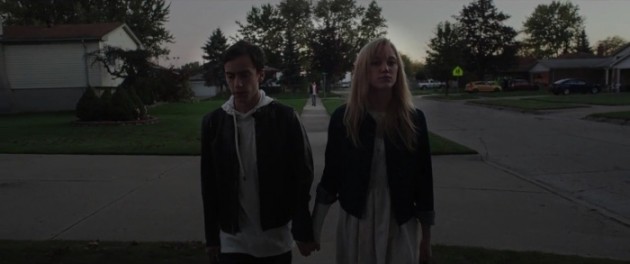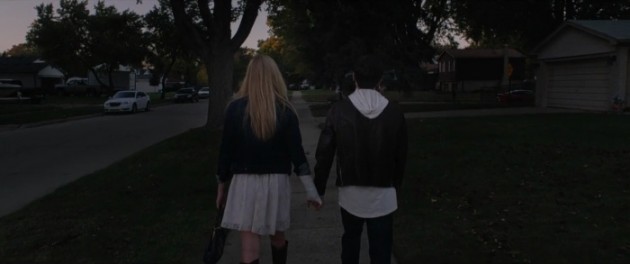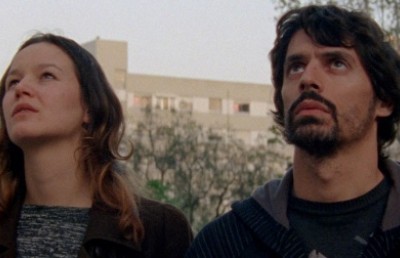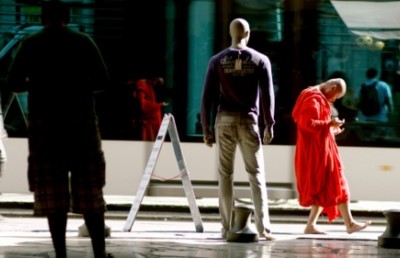FNC 2014: Rolling Out Temps Zero
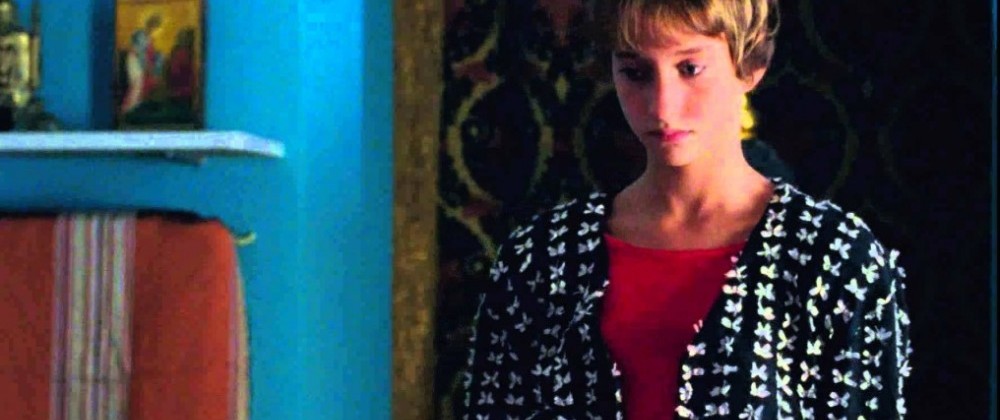
My report for the 2014 Festival of New Cinema will concentrate on the films from the Temps 0 section (with the exception of one stand-out film I just had to write about, The Girl Who Walks Home Alone at Night). Temps 0 is the brain child of Julien Fonfrede (interview here from 2012): ). Fonfrede’s past as a programmer for Fantasia sometimes shows with films that would not be out of place at Fantasia, and a healthy sampling of Japanese films (which remains one of Fonfrede’s favorite National cinemas). Fonfrede’s tastes ensure that the films in Temps 0 will be challenging, cutting edge and surprising. The purpose of Temps 0 since its inception about eight -nine years ago is to inject a youthful, ‘cool’ veneer to a Festival which is now in its 43rd year, but has always prided itself as being the city’s ‘hip’ festival.
Test (Alexander Kott, Russia, 2014)
The first film I saw at the festival was the Russian film Test (2014, Alexander Kott), a unique visual poem that eschews dialogue in favor of music, sound and action to tell a story of young love that conquers and is then conquered by military might. The film is whisper quiet until the final hydrogen bomb testing, an ending which recalls that of Zabriskie Point (1970, M. Antonioni). A 50 year old man named Tolgat and his stunningly beautiful daughter Dina live alone in Semipalatinsk, in the Kazak Steppes. A local Kazak boy, Kaisyn, has fallen in love with her, but she is smitten by a young Moscovite, Maxim, who is clownish compared to the more serious Kaisyn. The lack of dialogue foists the film in the arena of pure theatre and far removed from realism; in most scenes the characters seem like they have to talk to each other, but the contrived silence suggests directorial exercise. A few scenes or shots suggest perhaps a nod to Tarkovsky: the opening long take perpendicular tracking shot along a willow field; a reflecting water shot that resolves itself to reveal Dina and Maxim staring into a well. When Tolgat gets stuck out in the Steppes and returns late one night, he falls sick. Dina summons medical help. Her father leaves but returns a sick man (though he looks well). He soon dies and is buried by his daughter. The stillness of the film gives out to the finale, where the bomb explosion is impressively rendered with huge gusts of wind, CGI mushroom clouds, explosions that lift the desert sands and whirl it through space. In the bomb explosion Tolgat’s grave is up-ended and his corpse comes flying out of the earth. Quite surprisingly, all three protagonists are killed in the violent storm.
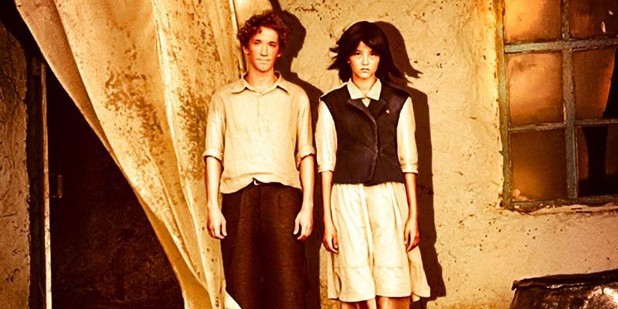
Test
Incompressa (Misunderstood, Asia Argento, Italy, 2014)
In today’s digital revolution it was heartening for someone who laments the loss of celluloid to learn that Incompressa (Misunderstood, 2014, Asia Argento, Italy) was shot on film, Super 16mm no less. Argento demonstrates a certain maturity with this film, which picks up her main thematics of her previous two films, Scarlet Diva (2000) and The Heart is Deceitful Above All Things (2011) : bad parenting or mightily dysfunctional families, but lightens up on the negativity and relies more on nuanced performance than theatricalism. The greatest leap forward is her directing of the performers, especially the children who are the most important characters in this film. Most notably the titular ‘misunderstood’ 9 year old Aria, played by the wonderfully photogenic Giulia Salerno, whose expressive eyes come to the fore when she cuts her hair to punkish short. Aria has two sisters, the older but developmentally retarded Lucrezia (Carolina Poccioni), who is 15 years old but lives in a pink dreamland (her bedroom is literally drenched in pink), and the in-between and the most sexualized by Argento’s camera, Donatina (Anna Lou Castoldi). To the latter point, the scene where Donatina is lying in bed wearing tight white underwear filmed with an over head camera that accentuates her form is notably uncomfortable.
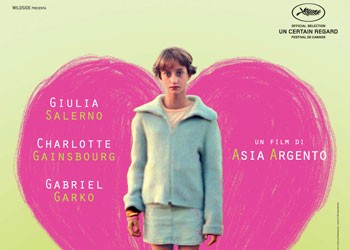
Raising the three children are egotistical, self-centered parents musician/classical pianist mother Yvonne Casella, played by Charlotte Gainsbourg, and matinee idol actor Dad, played by handsome Gabriel Garko. One of the noted themes Argento plays up is the fine line between artist parents whose unorthodox parenting skills are offset —if that is the right word— by a nonconformist environment which helps nurture their children’s own creative side. For example, Aria feels left out and unloved by everyone, her parents, the boy Adriano who she has a crush on, and her close school friend Angelica (Alice Pea) who gravitates toward the more popular Maria Teresa. This sense of feeling unloved is channeled into love of a cat, named Dac, and this then is channeled into an award winning essay she writes about Dac. She wins the best school prize for the best essay in all of Rome for her age group. The school fetes her award with a reading, which her mother promises she will attend. Two empty seats tell us otherwise, but Aria does not want to disappoint her supportive teacher, so gives a perfect reading of her award winning essay. This reading is nurtured by her own ‘creativity’ when she imagines her father and mother entering the room late and taking their place in front of her. Argento switches the visual style by increasing luminosity to enter into her mindscape, but for a short while we want to believe it is true, that her parents have acted responsibly and have provided us a feel good moment.
The film constantly shifts mood from drama/tragedy to broad comedy, like the opening scene where her mother persists in feeding her family nothing but meatballs. Aria does not eat them and puts them into her pocket (a cliché destination for undesirable food), while the father veers on a manic outburst over how much he hates meatballs! This sets up the father’s irrational behaviour always shifting from caring father to raving spoiled actor/model. Everything in his life is sifted through his acting, including a running series of superstitious beliefs that he feels will jeopardize his acting career. The father fears bad luck lurks behind every corner. The mother is no better, going through lovers like old socks: an Armani suited Italian coke head and a young American punk rock bassist whose rebelliousness appeals to Aria. Aria and the punk bassist become destructive allies for a while, crashing material items and spray painting the apartment. The bassist is also taken by Aria and cries and pleads like a little boy when Yvonne breaks up with him.
The film shows that kids can be just as cruel as adults. After a failed adult organized birthday party Aria organizes one herself at her father’s apartment while he is away, inviting all her school friends; surprisingly they all accept, including the too cool Adriano. (After he is implicated in a drug incident the father leaves for India, which may be an allusion to Terence Stamp, who left for India to step away from his recently attained mega-success). She goes to great measures to make the party a success, with cake and decorations. Things seem to be going fine until the set-up: a “Carrie”-style prank. They play a kissing game in the dark and she is matched up with the boy she is smitten by, Adriano, but when the lights turn up Aria discovers she has not kissed Adriano but a boy nicknamed ‘fatso’, who in turn has an attraction to Aria which she does not reciprocate (an irony Aria does not heed). All her friends begin to laugh and taunt her naivety, and end up trashing the apartment –suggesting an anarchistic theme bubbling under the film’s surface.
When the mother receives a package from her Armani-suited lover, the police walk in to arrest her for drug trafficking, revealing cocaine in the package. Yvonne plays dumb and feigns not knowing the sender but Aria seals her mother’s fate by —intentionally?— coming into the room and telling her mommy that the man in question has been at their house many times. Yvonne and Aria’s sister become venomous against Aria, blaming her for putting their mother in jail. But her stay is temporary; soon after her release from jail they have a party for Aria which is not kid friendly. Drugs are everywhere and when Mr. Armani shuts off Aria’s music in favor of a televised football match, Aria loses it and has an outburst.
Like Scarlet Diva, music is important in revealing the story significance but also reflecting the lead character’s energy and soul. The film takes place in 1984 and Argento does a great job placing us in the 1980s through clothes, hair style and music. Punk music and anarchic rock is the music Aria gravitates to. Aria’s only truly joyful moment with her father is tied to music. Her father shares his daughter’s love for a rock band, The Penelopes –we see a poster of them on her wall as she listens to their record– and tells her that he knows the band personally. He comes through on his promise of taking her to see their concert and arranges a backstage meeting with the band. The starry eyed look on Aria’s face when she stands off stage as they play is priceless. But the good times do not last long, and soon once again Aria is being shuttled back and forth between the two parents, who have no qualms locking her out late at night forcing her to walk alone at night.
The father’s manic behavior shines through when his nice gesture with The Penelopes is followed by a crass moment of favoritism when he leaves Aria home alone and takes Lucrezia to the circus. Saddened by being left out, Aria makes a half-hearted suicide attempt by swallowing some pills; but the parents do not heed the cry for help. Unwanted by both parents Aria is shuffled over to her maternal grandmother. With her self-esteem hitting rock bottom, Aria attempts suicide again, this one with more intent. Argento films it like Robert Bresson in the opening of La femme douce, using a synecdochic style to fragment the suicide into its parts. We see the balcony cement banisters; Aria walks up to them. The scene cuts to a slow motion close up of Aria’s head floating downward between the spaces of the banister; cut to the sound edited image of her corpse lying face down on the concrete patio floor. Next cut is to her bloodied face in a hospital cart being transported along a corridor. Will she survive? Argento ends with a Brechtian device: Cut to a shot of Aria with her back to the camera. She turns and faces the camera, and tells us that we should not see her action as an attempt for sympathy, but that she just wants to be understood.
Critics have been quick to label the film semi-autobiographical, and it is hard to imagine otherwise. Charlotte Gainsbourg looks like Daria Nicolodi, Asia Argento’s actress mother who was in a relationship with Dario Argento from 1974 to 1985. Asia Argento was born in 1975, which would make Asia the same age as Aria when the film takes place; and Aria looks like a young Asia. But the links to her real life most probably serve a similar function as in Scarlet Diva: setting up a familiar milieu of time, place, and mood, but adding fictionalized accounts.

Daria Nicolodi

Charlotte Gainsbourg

Asia Argento
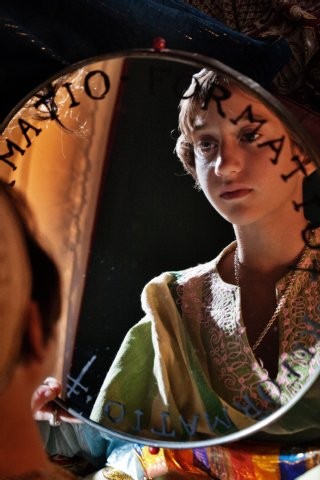
Giulia Salerno
Over Your Dead Body (Takashi Miike, Japan, 2014)
With Over Your Dead Body Miike takes on a classic 200 year old Japanese ghost story that has been filmed over 30 times, most famously by Nobuo Nagakawa, Yotsuya Kaidan (Ghost Story of Yotsuya). Miike honors the original setting of the story by filming it as a Kabuki play within the film set in present day Japan. In the contemporary setting famous actress Goto Miyuki (played by Ko Shibasaki) secures the role of Tamiya Lemon for her lesser known boyfriend actor Kosuke Hasegawa (played by Ebizo Ichikawa) to play opposite her lead role of Oiwa, in a retelling of the classic Japanese ghost story Yotsuya Kaidan. In the story within the story Kosuke plays the ambitious samurai Tamiya Lemon who viciously murders the disapproving father of a woman he wants to marry, Oiwa. Unaware that Lemon murdered her father, Oiwa marries him and bears him a child. Lemon still remains poor and sees a way out of poverty when a shady rich man offers him a lucrative job if he marries his granddaughter, Oume (played by Miho Nakanishi). Lemon’s desire for wealth sees him become an accomplice to an evil witch-like lady who slowly poisons his wife Oiwa and child (the poison causing the wife to have an ugly scar over her right eye, a constant reminder of his guilt). In pure classic Japanese ghost story fashion, the murdered wife Oiwa returns as a yurei, a vengeful female ghost, to haunt her murdering husband. The fictional stage treachery spills over into reality, as Kousuke Hasagawa (Ebizo Ichikawa) begins to have an affair with the younger actress who plays Oume, Rio Asahino.
Miike plays this out as a Kabuki period styled play on an impressive stage with revolving platform and wildly colored gel lights. Surrounding the stage is an audience (producers, directors?) seated at desks, as if studying the play. We appear to be watching the audience watch a rehearsal of a play. But to quote Shakespeare, “all the world’s a stage.” The film opens with a close-up of the entwined bodies of Kosuke and Miyuke making love. This is paralleled with the stage life, when Kosuke begins having an affair with a younger co-star, which itself is a mirroring of the treacherous relations going on in the stage play they are rehearsing.
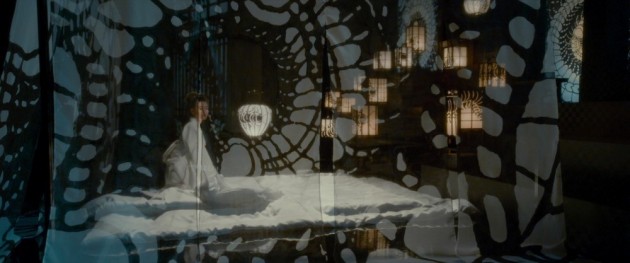
Impressive set from Over Your Dead Body
Over Your Dead Body is a highly stylized formal exercise in doubling, with great use of reflective surfaces, especially mirrors, highly controlled camera movements, color shifts in lighting, and sporadic bursts of excessive violence. Unlike other renditions of this tale, like the first great one by Nobuo Nagakawa, Miike’s film is as cool as a silver plate, all chrome and little warmth. It is no doubt a conscious choice but takes an emotional edge off the moments of horror, which are still eerie but in a steely sense. Sound design is as important as it is in Kiyoshi Kurosawa’s films, often forming the only signifier that the scene in question or shot in question is to unsettle us. As the film progresses violence increases, as does the ability to distinguish between art and life, the real from the imagined. The demon wife Oiwa and her father (killed viciously by Lemon and placed in a barrel) come back for vengeance. Lemon tears off the scar over Oiwa’s right eye (a sign of the impure) to reveal a hideous exposed eye. The father (or is it wife?) decapitates Lemon. We cut to the present reality with the police examining a car crash and a headless body (“We can’t find the head?”). This real/art violence has its equivalent in the wife’s eye (we see her smash her face up against the bathroom mirror). The film ends with a punch line: the upstart stand-in actress for Miyuki has the ‘missing’ head under her feet in the stage dressing room.
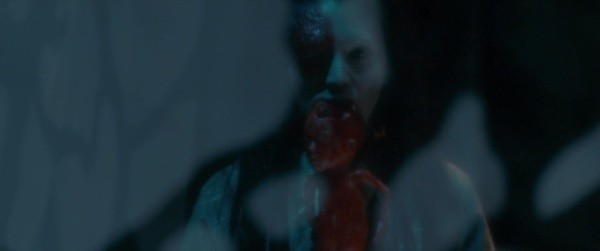
Lost Soul: The Doomed Journey of Richard Stanley’s Island of Dr. Moreau (David Gregory, US, 2014)
The old art vs. industry debate gets tweaked in this formally uninspiring documentary that remains engrossing nonetheless due to its mind boggling subject. Rather than a direct link to industry, the ‘art’ in question is challenged by star pride and ego, Val Kilmer and Marlon Brando sized. The doc sets up Richard Stanley’s pre-Moreau career as the director of Hardware, Dust Devil and documentaries The White Darkness and Secret Glory as a director marked by a visionary approach to genre: Hardware and Dust Devil were two iconoclastic films that tripped up the SF and supernatural genres with a heady mix of psychedelic and art house visuals. Stanley, a director on the vanguard, was one to keep an eye on for great things to come. After working hard on the pre-production of The Island of Dr. Moreau, and understanding it as both a literary piece and a philosophical think piece on social genetics, Stanley was primed to lead a bigger production to bringing to light his vision. Robert Shayne of New Line Cinema was the ticket. But after only four days, natural disaster (a monsoon that wiped away most of the set) plus the maniacal egoism of Val Kilmer led to Stanley being fired from the picture, which shocked and put into reckless retribution mode the lead actress Fairuza Balk, who was Stanley’s staunchest supporter in trying to get Stanley reinstated. Kilmer challenged Stanley at every step: grilling him about how a scene would be cut and then telling him that it could never cut in the editing room; arriving late to set or holing up in his trailer to delay filming. Stanley was replaced by Hollywood veteran John Frankenheimer, who had no empathy for the script, and was every bit as puzzled by Brando’s bizarre behavior, which included improvising his own costumes (like the all-white gown and make-up) . What the documentary never reveals is exactly why Kilmer had it in for Stanley. Four days doesn’t seem long enough to get to know someone so well as to hate them so much. One senses the documentary maker is on the side of Stanley in this debacle, but after hearing from a handful of the original crew members we learn that perhaps Stanley, with his drug use, esoteric interests, and iconoclastic nature was primed for the onslaught and not up to the muscular challenge of dealing with a huge scale project. In the end, The Island of Dr. Moreau is one of Hollywood’s great fiascos, and Lost Soul goes some distance in exposing the why and how of it.
Richard Stanley’s Introduction to a Screening of Lost Soul: Vimeo
A Girl Who Walks Home Alone at Night (Ana Lily Amirpour, US, 2014)
One of the standouts at this year’s FNC was an American indie film directed by an American-Iranian filmmaker/artist Ana Lily Amirpour, A Girl Who Walks Home Alone at Night, which showed in the Panorama section. The film is ostensibly a vampire film, but with a broad range of cultural and aesthetic influences which includes the western (notably spaghetti westerns), black and white art house cinema, with a strong Iranian diasporic identity: the vampire is a chador wearing young woman who stalks the streets like a prostitute but yields power over all the men she meets; with such a power-gender dynamic within the context of an Iranian society it is hard not to read the vampire girl as an avenging angel for all oppressed women in Iran.
What A Girl Who Walks Home Alone at Night is, is a nocturnal vampire dirge which bears some resemblance to a few recent horror/vampire films, namely Jim Jarmusch’s unique vampire take, Only Lovers Left Alive (2014), Let the Right One In, and Under the Skin, the latter also featuring an enigmatic, other-worldly taciturn female assassin, who quietly stalks her male victims. Contrarily, for some viewers A Girl Who Walks Home Alone at Night is more likely to recall older black & white arcane vampire films like Nadja and The Addiction, or Lynch’s Erasherhead, and Blue Velvet. Shot in a high contrast black and white, A Girl Who Walks Home Alone at Night takes place in a perennial night time in a post-industrial Iranian ghost town called ‘Bad City’. There is little else however, that identifies the city as Iran, and in fact the film was shot in California. The vampire, simply named ‘the girl’ (Sheila Vand), when not killing out of sheer survival, possess a moral compass, killing people who intimidate or act violently (a drug dealer and a man who aggresses a prostitute). The film moves at its own dreamy, hypnotic pace, underscored by cinematographer Lyle Vincent’s oppressively dark and grey landscape of dark urban, industrial streets. Like Let the Right One In, A Girl Who Walks Home Alone at Night is equal parts sad love story and alienation tale (and it is not just the vampires who are alienated, but the mortals). In Night the female vampire meets fellow loner Arash, who is slowly wasting away caring after his drug addicted father, who himself has not recovered from the loss of his wife. Their platonic relationship recalls the budding love between the vampire girl and young boy in Let the Right One In; and the open ended conclusion echoes that of Let the Right One In. In the latter film the young female vampire and young boy are on a train leaving their town. The vampire is stowed away in a luggage at the boy’s feet. In Night the vampire woman and human Arash leave the ‘bad city’ for a new start in Arash’s Thunderbird, with his cat sitting between them in the back seat. In both cases, the ending offers a glimmer of hope, but with the distinct possibility that the ‘unnatural’ relationships may turn sour.
It Follows (David Robert Mitchell, US, 2014)
My out and out favorite film from the Temps Zero section this year is It Follows, David Robert Mitchell’s follow-up to his debut The Myth of the American Sleepover (2010), an anti-teen teen film where we spend the last day of summer with a group of small town Michigan high schools kids. I’ve coined it an anti-teen teen film because, against generic expectation, there are no wild sex and drug parties, no excessive drinking or drug taking, or over the top teen stereotypes. Instead we get more introspection and down time than the usual teen coming of age film —though sex and thoughts of the opposite sex are still the main preoccupation. It Follows is even more of a bend on traditional genre, being, along with Toad Road and Absentia, the most unique indie American horror film of recent years. I doubt there will be many, if any, horror films ‘following’ the paradigm set by It Follows.
Although it shares a great deal with Halloween (suburban setting, repetitive scenes, music, intense use of off-screen space as a site of potential horror, startles) It Follows does not have a generic plot or catchy hook that other filmmakers can turn into a formula, as happened with Halloween. Like The Myth of the American Sleepover, the film is not afraid to examine the down time in between the generic elements: characters hanging by the pool, chatting on the porch, or reading thick novels on e-readers. It is quite simply one of the most audaciously original American horror films since Toad Road –another film which has quietly come and gone largely because of its searing originality (and based on advance notice and trailer views, Toad Road director Jason Banker’s upcoming second feature Felt seems to confirm this director’s pedigree as a risk taker) . The plot deals with a ‘network’ horror with only one character in real danger at one time, until they can send the fear to another ‘victim’, like “Ringu’s” chain video. But what makes this different from Ringu and other chain link horrors, is that the person who is the ‘camera’ of the personified demon/monster still remains in the picture after they have passed on the curse to someone else because if the ‘prey’ is caught by the ‘spirit’ the curse spirals backwards to the previous victim; so the ex-carrier of the curse has a vested interest in ensuring the current carrier does not succumb. The twist here is that people are forced to care for others, since apathy leads indirectly to one’s own harm. Can the film be a sort of moral message to get young people to care beyond their cell phones for actual human beings? The theme of the connected curse that must be passed on goes back to the “Casting of the Runes” aka Curse of the Demon, and the cited Ringu films. Plus a recent supernatural possession film, At the Devil’s Door (2014, Nicolas McCarthy) which also used the device of a spirit that jumps from one body to another. What also makes this unique is its simplicity of design and lack of the usual moral element that finds its way in horror films. These people are not victims because they did something or did somebody wrong, or were promiscuous, but because they simple ARE. In fact, being promiscuous helps, recalling the revisionist slasher film Cherry Falls 2000. The way for the carrier to pass on the curse is to sleep with someone that ‘loves’ them. In Cherry Falls the serial killer only victimizes virgins which sends the community’s teen virgins off looking for sex –opposite to the usual slasher morality. The film also invites ambiguity and suggestion with certain oddly placed scares and moments, like the one where Jay (Maika Monroe), the victim-heroine, hears men fishing and drinking off-shore on a boat and swims off to meet them. The scene cuts before she arrives at the boat and is never referred to again. Our first thought is that she went there with the hope of offering herself to the men, but the scenario seems all wrong: would a seemingly sensible girl like Jay do something that potentially dangerous?
The film also scores many points in my book for being contemporary but succeeding in its attempt to recreate a retro vibe of the 1970s and 1980s horror, specifically in its wonderful synthesizer soundtrack by Disasterpeace and its use of period design and costume. There are many 1970s cars around and the only sign of the digital revolution is a book e-reader in the shape of a seashell the bespectacled character uses to read The Idiot; the only scene where a cell phone appears is in the opening death scene, otherwise there is an absence of computers, Facebook or Twitter. The teen characters dress in casual jeans and do not use current lingo. Recalling the films of Wes Craven, parents are pretty much not existent –the teen characters keep saying “We can’t tell Mom” and never seek help from an authority figure. And the music is a revelation, recalling Carpenter’s tuneful minimalism but also the melodic refrains of Colin Towns’ score for Richard Loncraine’s melancholic The Haunting of Julia (1976).
The film opens a teenage girl running out of her suburban home, in scanty night gown, running around her quaint neighborhood, but with a nervous sense of aimlessness; a common space now seeming estranged to her no doubt. The scene is handled in one long take Steadicam shot, which becomes a formal motif: long lateral tracking shots or 360 degree camera pans that encircle characters and spaces and represent the film’s ‘looping’ plot and theme; a movement which traps us into this visual circle where our view is bound and restraint by the ongoing sense of circularity, the de-limiting movements. The girl is running as if being chased by an unseen force. She runs back to the house, the father coming out to call out her name. She comes back out, and drives off to the beach, where she sits alone on the sand, takes out her cell phone (the only time we see a cell phone) to leave a plaintive cry of forgiveness (for what?) to her parents, excusing herself for not being a better daughter. But we see no reason for her mounting fear. The scene cuts away and back to the beach later with the young woman transformed into a grotesque misshapen body, her legs jutting up in an L-shape, cut off at the knees and feet.
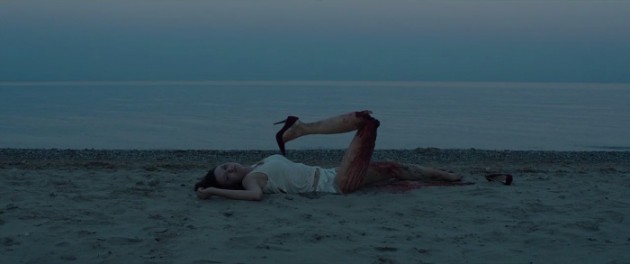
The First Victim
I am not sure, but I think this victim #1 returns once, as a follower, but the film then cuts to the central group of protagonists, three teen sisters, Yara (Olivia Luccardi), Jay and Kelly (Lili Sepe) and boyhood male friend Paul (Keir Gilchrist) who has a serious long standing, unrequited crush on Jay. The titular ‘followers’ can only be seen by the victim, which leaves the victims the difficult task of trying to convince their friends and loved ones that they are not going crazy. The Followers usually appear walking slowly into the frame from the background, at a pace quicker and more determined than a zombie but not fast; the appearances of the followers recalls the great moment in Carpenter’s In the Mouth of Madness where a crazed spectator walks out of a movie theatre and straight across the street to where our hero is sitting inside a café, smashing through the glass to attack the seated man. The film also treats an interesting idea of space and limits and boundaries in a purely horrific way –on that side of the fence is fear– but also political by invoking the class element, as the scene where they cross-over from the suburbs into the inner city Detroit and encounter a Detroit as a harrowing space, as if they have entered a post-apocalyptic war zone, an economic wasteland; recalling the eerie neighborhood the all-American kids enter in Philip Kaufman’s The Wanderers. The followers are themselves not all creepy, not always gruesome, sometimes they are simply dressed; or nude, as a woman, another is an unusually tall man; another a slightly disfigured woman; an old lady (at school); or they can take the shape of a loved one or a friend: we see her young sister with glasses as one, and the cool guy/lover she picks up across the street seems to come back as his own haunter.
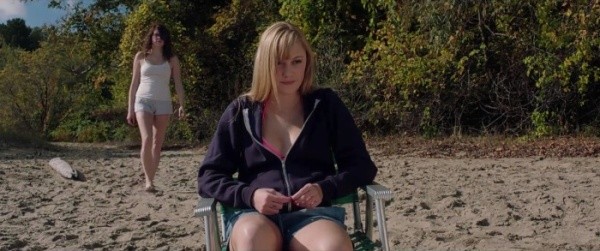
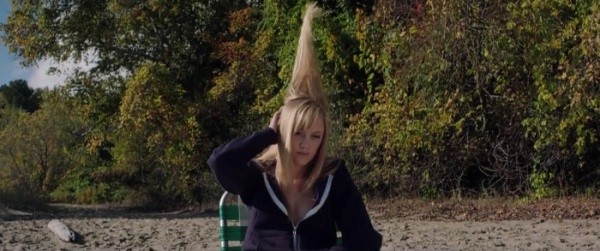
A Follower sneaks up on Jay
The only apparent misstep in the film is the attempt to ‘materialize’ and kill a Follower in the concluding pool scene. They place a booby trap (another Craven touch) in a swimming pool to trap and materialize the form so they can shoot and kill the follower. The Follower appears in the shape of Jay’s dead father —we assume he is dead since he is seen only in family photographs around the house. They seem to succeed in defeating the invisible spirit, suggested by the mass of red swirling blood forming in the pool. There is a second way of reading this scene that holds a potential key in explaining what the followers represent. Although the first victim explains how the curse operates there is no explanation for why the curse began, or what it may signify. Mitchell leaves this up to the viewer to decide, but perhaps suggests a possible explanation through intertextuality. The first thing that came to mind while watching the pool scene was the much more effective pool scene at the end of Let the Right One In. But on further thought an older and more intriguing film reference came to mind: the pool YMCA swimming pool scene from the original Cat People (1942). The way Mitchell lights the scene, with the shimmering water reflections and shadows on the pool walls and the low key atmosphere seems a direct allusion to the earlier film, which is one of the seminal Freudian horror films. In Cat People Ivona Dubrovna (Simone Simon) ‘turns’ into a leopard (figuratively or literally) whenever her barely repressed desires and sexual jealousy manifests itself. The woman being stalked by Ivona’s shadowy presence in the swimming pool is a co-worker, Alice Moore (Jane Rudolph), of the man Ivona desires, and eventually marries, Oliver Reed (Kent Smith). Ivona’s jealousy over the close working relationship between Alice and Oliver manifests itself in this pool attack; even though we never see Ivona, Alice does act as if there is a presence in the pool area, we hear possible cat sounds, see flickering shadows, and the physical evidence of Alice’s torn towel. In common Freud speak, the presence of the pool acts as a metaphor for the unconscious, as do the dark shadows and shimmering water, adding up to the proverbial ‘return of the repressed’ in the form of a dark force. If we map this idea of the unconscious onto It Follows then it helps explain what is left unsaid in the film’s plot: the ‘things’ following the victims are a subjective projection of their own deepest unconscious fears. This would explain why only the victim sees their attacker; and why the attackers sometimes appear as people close to the victim, like Jay’s sister and father; and in the case of Greg, the boy Jay passes the curse to, first as himself, and then as his still living mother.
In the next scene Jay and Paul have sex. Does this mean the curse will be transferred to Paul? It ends with Jay and Paul walking hand in hand along the sidewalk in the quiet yet now unsettling suburban neighborhood. They are finally a couple. Then we catch a glimpse of someone walking far behind them on the sidewalk framed symmetrically between them……another follower? It cuts behind them to what could be a potential follower’s point of view….and it cuts to black. Is the curse really over? Can it ever be? Do we want it to be?
